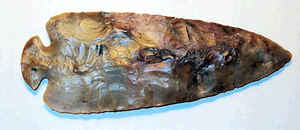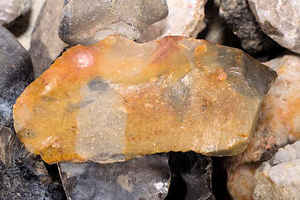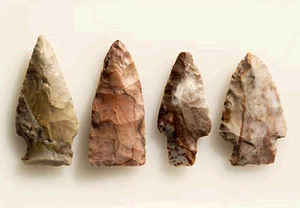Ohio Gemstone or Gem
Ohio Flint

(SiO2)
Adopted in 1965
Ohio flint is known to rock and mineral collectors throughout the country for its brilliant colors and its suitability for crafting into beautiful jewelry. It was appropriate, therefore, that in 1965 the Ohio General Assembly named flint, (SiO2,) Ohio's official gemstone.
Ohio Flint: Ohio Gemstone Stone

The state gemstone is flint, originally used to make spear-points and arrowheads by the Native Americans who lived in the area.
Flint, a variety of quartz, is a hard, durable rock that is composed of silicon dioxide (SiO2), or silica. Minor amounts of chemical impurities
commonly impart a wide variety of colors to flint, in shades of red, pink, green, blue, yellow, gray, white, and black, which may be intricately intermingled.
Its color, hardness, and ability to take a high polish make Ohio flint a coveted item among lapidarists, who produce unique jewelry items from this
rock.
 Flint (and its impure form, chert) is widely distributed in Ohio in rocks
of Silurian (438 to 408 million years ago), Devonian (408 to 360 million years ago), and Pennsylvanian (320 to 286 million years ago) age. These rocks
were deposited in shallow, tropical seas that covered the area that is now Ohio during the Paleozoic Era. Most flint deposits are associated with marine
limestones, and it is thought that the silica necessary to form flint was derived from the siliceous spicules that formed the skeletal support for
sponges that lived in the seas.
Flint (and its impure form, chert) is widely distributed in Ohio in rocks
of Silurian (438 to 408 million years ago), Devonian (408 to 360 million years ago), and Pennsylvanian (320 to 286 million years ago) age. These rocks
were deposited in shallow, tropical seas that covered the area that is now Ohio during the Paleozoic Era. Most flint deposits are associated with marine
limestones, and it is thought that the silica necessary to form flint was derived from the siliceous spicules that formed the skeletal support for
sponges that lived in the seas.

The most famous deposit of flint in Ohio is an area in eastern Licking and western Muskingum Counties known as Flint Ridge. The Vanport flint of
Pennsylvanian age covers a ridgetop area of about 6 square miles. The flint deposit ranges in thickness from about 1 foot to 12 feet.
Flint Ridge flint is noted for its array of colors and suitability for jewelry making and for its long and widespread use by American Indians. Hundreds
of pits dotting Flint Ridge are evidence of the extensive quarrying of flint by a succession of American Indian cultures. The earliest peoples to use
this raw material for various tools, including knives, scrapers, and projectile points, were the Paleo-Indians, a culture that was contemporaneous
with the last phases of the Pleistocene Ice Age and extinct animals such as mastodon and mammoth that roamed the area until about 10,000 years ago.
It is thought that American Indians from throughout the Midwest made periodic pilgrimages to Flint Ridge in order to obtain a supply of flint for tool making. The purity of this deposit permitted these skilled workers to fashion a wide variety of tools, weapons, and ceremonial pieces. Artifacts made from Flint Ridge Flint have been found as far east as the Atlantic coast, as far west as Kansas City, and as far south as Louisiana.
Ohio Law
The law designating the Ohio Flint,a crypto-crystalline variety of quartz, as the official Ohio state gem is found in the Ohio Revised Code, General Provisions, Chapter 5, Section 5.07.
GENERAL PROVISIONS
CHAPTER 5: STATE INSIGNIA; SEALS; HOLIDAYS
SECTION 5.07
§ 5.07 Official state gem stone.
The gem stone "Ohio Flint," a crypto-crystalline variety of quartz, is hereby adopted as the official gem stone of the state.
History
HISTORY: 131 v 5. Eff 8-24-65.
Minerals, & Gems

Gemstone, Minerals, Rocks







